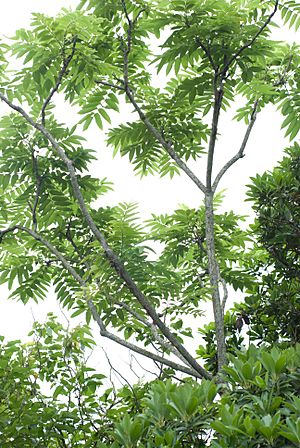Ailanthus-like prickly ash facts for kids
Quick facts for kids Ailanthus-like prickly ash |
|
|---|---|
 |
|
| Scientific classification | |
| Genus: |
Zanthoxylum
|
| Species: |
ailanthoides
|
Zanthoxylum ailanthoides, also known as ailanthus-like prickly ash, is a fascinating plant from Asia. It's part of the Zanthoxylum genus, which includes many types of prickly ash plants. You can find it growing naturally in forests across southeastern China, Taiwan, Southeast Asia, and Japan. In Japan, it grows from the island of Honshu all the way south.
This plant has several interesting names. In Chinese, it's called chun ye hua jiao, which means "Ailanthus-leaved pepper," or shi zhu yu, meaning "edible shān zhū yú." In Japanese, it's known as karasu-zanshō, or "crow prickly ash."
What is it used for?
Long ago, before many new plants were brought to Asia, the spicy fruit of Zanthoxylum ailanthoides was used in China. It was a local replacement for red pepper, adding a kick to food. In Taiwan today, the young leaves of this plant are still used in cooking. They add a unique flavor to dishes.
Even though it's called "Japanese prickly-ash" sometimes, that name can be a bit confusing. This is because another plant, Zanthoxylum piperitum, is also sometimes called "Japanese prickly-ash" or sanshō. In Japan, people don't usually eat Z. ailanthoides today. However, ancient people from the Jōmon period might have eaten it. Interestingly, Japanese macaques, a type of monkey, like to forage for this plant in the wild.
Why is it called ailanthoides?
The Latin name ailanthoides for this plant comes from its leaves. They look very similar to the leaves of the Ailanthus tree. This is a good way to remember what the plant looks like!
A Home for Butterflies
Like many plants in the rue family, Zanthoxylum ailanthoides is very important for butterflies. It serves as a "host plant" for the larvae (caterpillars) of several types of Asian swallowtail butterflies. This means the caterpillars eat the leaves of this plant to grow. Some of these beautiful butterflies include Papilio bianor, Papilio helenus, Papilio protenor, and Papilio xuthus.
See also
 In Spanish: Zanthoxylum ailanthoides para niños
In Spanish: Zanthoxylum ailanthoides para niños

